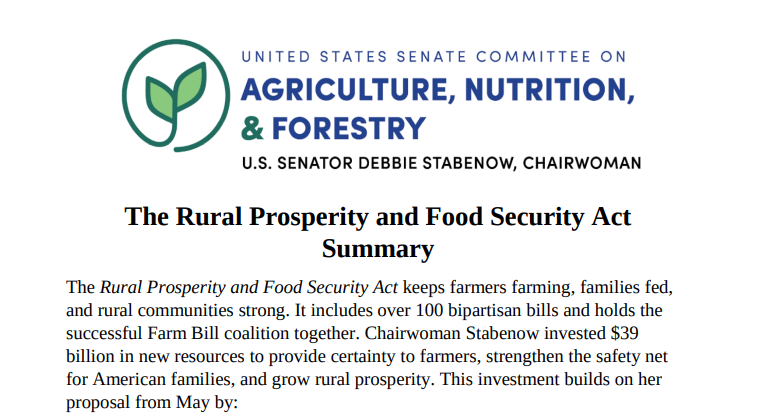House Republicans are planning to revive farm bill negotiations in January after failing to garner enough political will to pass a new deal by the end of the year, as…
Stabenow Releases Lame-Duck Farm Bill Text
Agri-Pulse’s Philip Brasher reported Monday morning that “Senate Agriculture Committee Chairwoman Debbie Stabenow, D-Mich., released the text of her draft farm bill on Monday with just weeks remaining in this Congress and more than five months after releasing a detailed summary of the proposal.”
“The 1,397-page bill would limit President-elect Donald Trump’s use of the Commodity Credit Corporation account to compensate farmers for trade losses as he did in his first term,” Brasher reported. “The top Republican on Senate Ag, John Boozman of Arkansas quickly rejected the proposal. ‘An 11th hour partisan proposal released 415 days after the expiration of the current farm bill is insulting. America’s farmers deserve better,’ he said in a post on X.”

Progressive Farmer’s Jerry Hagstrom and Chris Clayton reported that “Stabenow is retiring at the end of this Congress, and her decision to release the text is a signal that she still hopes Congress will pass a farm bill before it adjourns, or at least put her detailed, 1,397-page proposal on the table. Congress has a lot to do before it adjourns — including passing a measure to fund the government, the National Defense Reauthorization Act, as well as dealing with disaster aid. The prospects for passage of a farm bill appear slim.”
“‘The foundation of every successful farm bill is built on holding together the broad, bipartisan farm bill coalition. This is a strong bill that invests in all of agriculture, helps families put food on the table, supports rural prosperity, and holds that coalition together,’ Stabenow said in a news release,” Clayton reported.
What’s in the Bill?
Brasher reported that “the bill includes a 5% increase in reference prices for the Price Loss Coverage program, and changes to the reference price escalator that would increase the effective reference price after periods in which market prices have been elevated.”
“The bill would provide $39 billion in increased funding by restricting USDA’s use of the CCC from 2025 through 2030 unless the department has congressional authority. The bill says the CCC ‘is authorized to use its general powers only to carry out operations as Congress may specifically authorize or provide for,'” Brasher reported. “The Congressional Budget Office would be directed to estimate the savings of the provision at $6.7 billion per year. The provision could potentially restrict the ability of the Trump administration to provide assistance to offset the impact of retaliatory tariffs. She told reporters her bill ’embraces’ the Republicans’ method of paying for increased commodity program funding, referring to the CCC restriction. She said the bill also would provide payments to farmers faster than they get them now under the 2018 farm bill.”
“Under the Stabenow bill text, the reference prices would be set at $3.89 for corn (up from $3.70 under the 2018 farm bill), $8.82 for soybeans (up from $8.40), $5.78 for wheat (up from $5.50), and 38.5 cents for cotton (up from 36.7 cents),” Brasher reported. “The Agriculture Risk Coverage guarantee would be increased to 88% of the benchmark revenue, up from 86%. According to the release, the bill would provide $20 billion ‘to strengthen the farm safety net to support all of agriculture and establishes a permanent structure for disaster assistance so emergency relief reaches farmers faster,’ $8.5 billion ‘to help families make ends meet, put food on the table, and improve access to nutrition assistance,’ and $4.3 billion ‘to improve quality of life in the rural communities that millions of Americans call home.'”
Hagstrom and Clayton reported that “the bill ‘tackles the climate crisis’ by locking in the dollars from the Inflation Reduction Act (IRA) to boost conservation programs. ‘These programs pull carbon out of the air and place it in the soil for healthier farms and a more resilient future.’ The House farm bill decouples those IRA conservation dollars from applying strictly to ‘climate-smart’ practices.”
How the Bill Differs From the House Version
Roll Call’s Olivia M. Bridges reported that “the Senate bill still differs from the House bill in ways that may be difficult to overcome in the few legislative weeks available before the 118th Congress ends.”
“The bills differ over the size of increases to the so-called farm safety net. Stabenow still says she opposes House Republican efforts to link food stamp benefits to inflation. Her bill also would restrict the Agriculture secretary’s use of Section 5 authority over the Commodity Credit Corporation, but for half the time House Republicans favor,” Bridges reported. “And both bills still need to be paid for. They would raise spending above the baseline and would need to find offsetting revenue or cost cuts — or get the budget committees to override the Congressional Budget Office score.”
Click here to read a summary of the bill. Click here to read the full bill text.





